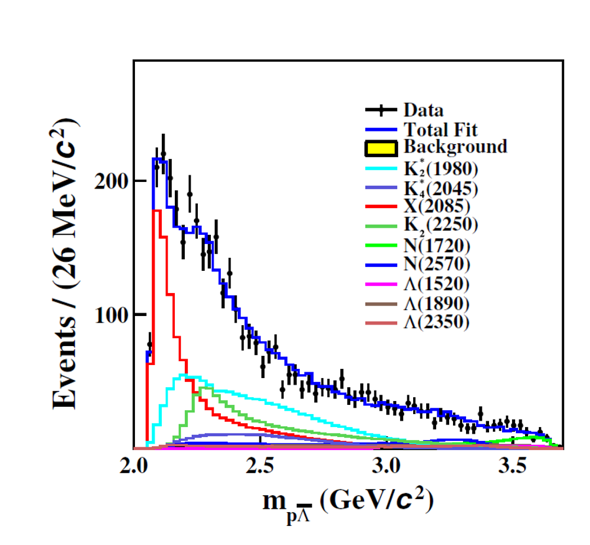The BESIII collaboration has recently reported the observation of a narrow structure near the pΛbar threshold in the e
+e
-→pK
-Λbar+c.c. process. Its quantum number J
P is determined for the first time and the resonance parameters are also determined. The detailed results have been published in the journal Physical Review Letters 131, 151901 on Oct. 10 2023.
Study of the exotic states beyond conventional mesons and baryons is one of the main interests in hadron physics. The abnormal enhanced structure near the pΛbar threshold was firstly observed in the process of J/ψ→pK-Λbar+c.c. by the BES collaboration and also reported in several other charmonium and B meson decays. Theoretically, this enhancement has been investigated in various scenarios, including q3qbar3 meson, baryon-antibaryon SU(3) nonets, final states interaction, and chiral effective field theory. Determination of the spin-parity quantum number as well as resonance parameters provide critical information to validate these theoretical models.
FIG. 1. The fit projection on the pΛbar invariant mass spectrum in the e+e-→pK-Λbar+c.c. decay. The pΛbar near threshold enhancement structure is denoted as X(2085).
Based on the data sets collected at the center-of-mass energies √s=4.008, 4.178, 4.226, 4.528, 4.416 and 4.682 GeV with a total integrated luminosity of 8.35 fb-1, a significant near threshold enhancement structure is observed in the pΛbar invariant mass spectrum, as shown in Fig. 1. Further amplitude analysis result at √s=4.178 GeV favors its spin-parity quantum number to be 1+ with a statistical significance greater than 5σ over 0-, 1-, and 2+, while the statistical significance of 1+ over 2- falls within 3.1~7.5σ. The resonance parameters are measured to be M=(2086-2+4±9) MeV and Γ=(56-3+4±25) MeV by combining all six energy points.
The quantum number 1+ suggests that the pΛbar system forms a P-wave structure. The resonance parameters match neither any known excited kaon states observed in experiments nor any state predicted by potential model. The anomalous narrow width and the mass near the pΛbar threshold may indicate some exotic properties.
The PRL publication:
DOI: 10.1103/PhysRevLett.131.151901


